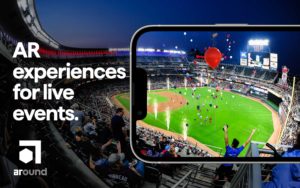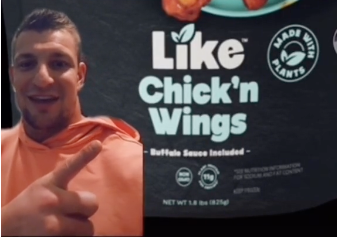By
Jen Wood
SVP, Integrated Marketing
Allison+Partners
CONTACT
hello@stagwellglobal.com
SIGN UP FOR OUR INSIGHTS BLASTS

When NIL legislation became law in July 2021, it opened the floodgates for college athletes to partner with companies and monetize their success. Historically, NIL opportunities were talked about in terms of appearances and autographs. But unsurprisingly, the bulk of all NIL deals to date have leaned on the success of digital solutions from social media posts and content to NFT creation.
The first nine months of this marketplace have seen a flurry of activity, but have also exposed a few opportunity areas:
- Despite NIL legislation being touted as benefitting all college athletes, recent data from the platform Opendorse shows 51.1% of all NIL compensation has gone to college football players and 72.6% of all compensation has gone to male athletes.
- Many experts say this imbalance is a result of systemic inequities that exist in sports. Brands could help correct this imbalance by purposefully crafting NIL programs that highlight a diverse representation of athletes across both men’s and women’s sports.
- Even though there’s a desire from all stakeholders to have uniform NIL standards, there’s currently no governing body overseeing this. Depending on your industry, it’s still a bit of the Wild West in terms of who you can partner with. Rules differ by college and conference, leading some conferences to allow NIL partnerships with alcohol and sports betting companies, for instance, while other conferences and schools do not.
- Brands must do their due diligence before approaching an athlete and hire an agency, especially if they’re in a highly regulated industry, to help navigate the constantly changing landscape and make recommendations around the athletes who can help achieve their goals.
- There is great variability in the savviness and experience of those negotiating these deals, with some athletes represented by traditional agents and other athletes left to negotiate on their own. Some universities, such as Ohio State’s NIL Edge Team, have formed expressly to help athletes navigate this void. This creates inconsistencies in how services are priced and opens the door for certain athletes to be taken advantage of.
Partnering with a college athlete, as with any influencer, comes with risk. Not only are proper vetting and contract structure essential to a successful partnership, but athlete deals have more visibility than traditional influencer relationships. This heightens the opportunity for brands to be called out for unfair practices. Using tools, such as A+P’s Influencer Impact Score, helps provide consistent vetting and pricing guidance to ensure each deal is approached equitably.
One thing is for certain – the NIL marketplace’s size and influence will continue to grow. And athlete brand-building efforts will continue to be a huge focus, taking an even larger role in recruitment efforts. Not only will colleges seek to recruit college athletes who are already influencers and can bring that follower base to their school, but they’ll also look to market their institutions’ ability to help athletes build their personal brand by playing at the university. Expect athletes across all college sports to become savvier about their marketing potential and create an exponentially larger industry marketplace.
Jen Wood is senior vice president of Integrated Marketing at Allison+Partners. She’s spent the past 10-plus years of her career in Sports Marketing and Sponsorships overseeing all aspects of her clients sports marketing efforts – from sponsorship strategy development and partner identification, to negotiating multi-million-dollar sponsorship deals with collegiate and professional sports organizations and athletes, partnership activation, and ultimately measuring asset utilization and performance. She’s passionate about the opportunities sports marketing provides and is always ready to chat with an interested brand.
Related
Articles
In the News, Marketing Frontiers, Press Releases, Stagwell Marketing Cloud
Apr 02, 2025
The European Commission Expands its Partnership with UNICEPTA by PRophet to Include Media Analysis

Artificial Intelligence, In the News, Marketing Frontiers, Press Releases
Apr 02, 2025
Stagwell (STGW) Appoints John Kahan as Inaugural Chief AI Officer

In the News, Investments & Financials, Press Releases
Apr 02, 2025
Stagwell (STGW) Will Host 2025 Virtual Investor Day and Announce $5 Billion Revenue Target by End of FY29

Newsletter
Sign Up
For realtime insights, follow us on LinkedIn
A roundup of Stagwell’s work at Super Bowl 2022:
Stagwell’s agencies are transforming marketing – on one of the most captive fields for national marketing, the Super Bowl. Several of our agencies are showing up at the Big Game this year: Anomaly for Meta, Vroom and Expedia; 72andSunny for the NFL; Forsman & Bodenfors for Polestar; and more. Off the TV screen, our agencies are innovating with omnichannel efforts that tap into the fever and fandom of the big game to drive powerful consumer moments for their brand partners.
We believe that there’s a new definition of success for advertisers at the Super Bowl, and it’s driven by digital transformation and changing consumer expectations around brands and experiences. Stagwell is leading the charge in supporting brands as they navigate this new dynamic – explore Stagwell’s presence at The Game, both traditional and less so, below.
But before you dive in:
Captain Morgan x Anomaly
Captain Morgan’s high-tech punch bowl syncs with real-time game data to keep fans in the loop, even when they’re getting a refill.
Meet the Super Bowl snack table addition you never knew you needed: the Captain Morgan Super Bowl Punch Bowl. Anomaly worked with the Captain Morgan team to bring to life the bowl, featuring stadium-inspired lights and sound, Bluetooth speakers, subwoofers and LED graphic equalizers that sync with real-time game data to create an immersive brand experience.
Plus, don’t miss it’s apperance on Jimmy Fallon.
Cenex x Colle McVoy
Colle McVoy created a new campaign for Cenex that celebrates the quirky, charming and often humorous moments of connection that people experience at their local convenience stores. The campaign shows how its 1,500 locations in 19 states power communities while helping to connect people. It’s the next evolution of the brand’s successful Powered Locally platform and includes six :15 spots, two debuting in a few weeks during Super Bowl 56 in 20 Midwest regional markets.
Crosstown Rivals (premiering 2/13/22)
Local Entertainment (premiering 2/13/22)
CUE Health x Doner
Like COVID itself, at home testing company CUE is quick to adapt, putting together a spot in just eight days with Doner. Voiced by Gal Gadot, the ad positions the smart at home testing technology in conversation with a family’s other smart home devices – just another addition to the growing suite of at technologies that keep us safe, run more efficiently, and provide peace of mind. And while COVID is top of mind now, CUE promises that they’re just getting started.
How COVID Testing Brand CUE Put Together a Super Bowl Ad in 8 Days (AdAge)
Expedia x Anomaly
Ewan McGregor gives a convincing plug for the power of experiences over ‘stuff’
As the travel industry looks to continue to gain footing and recover from COVID-drivel losses, Expedia is leading the pack in its commitment to the Big Game with a spot created by Anomaly. With an emphasis on experiences over things, the spot aims to redefine the relationship between the platform and its customers, while challenging the expectations that travelers may have for Expedia and its sister brand, Vrbo.
‘Ewan McGregor and Expedia have Teamed Up to Give Away Free ‘Trips’ on Super Bowl Sunday’ (Forbes)
‘Why the 2022 Super Bowl Makes Sense for Brands’ (AdAge)
‘Can Super Bowl Ads Make Expedia Group the Nike of Travel?’ (AdWeek)
Groupon x Allison+Partners
Gronk is getting out of town… and opening his hope to one lucky winner for the experience of the lifetime.
Allison+Partners led PR for Groupon’s “Party Like a Player” Super Bowl sweepstakes campaign featuring Rob Gronkowski that underscored the brand’s positioning as the go-to experience marketplace. The team secured coverage in USA Today, TMZ Sports, ABC Audio, Travel + Leisure and many more resulting in 3.7B impressions (and counting) in its first week.
LikeMeat x 72andSunny
LikeMeat is celebrating the Big Game with a TikTok scavenger hunt, created by 72andSunny and Blue Hour Studios. To promote its plant-based Chick’n Wings product launch, LikeMeat has invited TikTok users to hunt for digital clues that crack a secret code. Those who unlock the code have a chance to win two free tickets to the Super Bowl as well as other LikeMeat-branded prizes. It’s yet another example of brands going digital-first for the big day, eschewing traditional spots for lower-budget, higher impact activations to connect with their audiences.
Why a plant-based food company started the first TikTok scavenger hunt featuring Gronk just in time for the Super Bowl (Digiday)
Got Milk? x GALE
The milk industry is making a statement at this year’s Super Bowl – that what you’re seeing on the field is not the whole picture. Their spot, airing on the NFL Network and created by GALE, is an inclusive look at the power of women in sport, even (and especially) where they aren’t expected. Featuring women from across the Women’s Football Alliance, the tagline “Football is Football” encourages a broader look at the game and the powerful changemakers behind it.
NFL x 72andSunny
After topping the USA Today Ad Meter last year, 72andSunny + NFL are returning to the screens this year just before halftime with another spot that aims to capture the magic, legacy and power of the game. Featuring cutting edge puppetry and CGI technology from experts at Swaybox, the ad features legendary NFL talent in unexpected places and spaces – bringing the game right into viewers homes. Get ready to bring down the house.
‘
”They Will Be Blown Away’: NFL’s Next Step in ‘Future-Proofing’ Audience Begins with a Super Bowl Ad’ (USA Today)
‘Behind the NFL’s Super Bowl Ad Plans, Which Include Puppetry and CGI’ (AdAge)
Polestar x Forsman & Bodenfors
In it’s first Super Bowl ad, Polestar, the high-end EV company with roots in Sweden, joined a spate of automakers – with a very different approach. The minimalist 30-second spot, executed by F&B, places a focus on what it doesn’t have – gimmicks, punchlines, scandals and distractions. It’s all about the future, driven by electric.
‘Swedish EV Startup Polestar Makes Super Bowl Debut with a “No Cliche” Approach’ (Ad Age)
Quest Oculus for Meta x Anomaly
In it’s first Super Bowl as the newly-rebranded Meta, Oculus Quest is doubling down on the metaverse, with a clear message to the audience – the metaverse is already here, and we’re waiting for you. The full spot, created by Anomaly and premiered on Good Morning America on Feb. 10, shows a metaverse in full swing – including a very-real post-game concert that will be headlined by the Foo Fighters. Its giving people a reason to visit the virtual reality world Meta is building – and pulling viewers into the future they are creating.
‘Inside Meta’s Super Bowl Commercial for the Metaverse’ (AdAge)
‘Meta’s Super Bowl Commerical Depicts Old Brand’s New Life in the Metaverse’ (AdAge)
Tillamook x 72andSunny
72andSunny created a shoppable, digital only music video, Chedderbration to mark National Cheddar Day coinciding with the Super Bowl. The multimedium campaign includes limited edition merch, unique cheddar-based recipes, and coupons accessible only through the Cheddarbration homepage.
Vroom x Anomaly
Vroom’s Super Bowl 2022 commercial sings the praises of a reliable broker – literally
Anomaly makes a return Super Bowl appearance with Vroom, the online car retailer who is literally singing the praises of having a reliable dealer on your side during the car selling process. The 30 second spot again features high-tempo choreography from celebrity choreograper Mandy Moore.
‘Vroom Releases Super Bowl 56 Ad ‘Flake: The Musical” (AdAge)
Related
Articles
In the News
Apr 24, 2025
WHAT THE DATA SAY: 45% of Gen Z say AI has made college degrees irrelevant
Gen Z says AI has made college degrees irrelevant, according…
In the News, Press Releases
Apr 23, 2025
MEET BOBBIE, A NEW INFLUENCER AND CREATOR MARKETING AGENCY
HUNTER, a leading Stagwell (STGW) marketing communications agency, today announced…
In the News, Investments & Financials, Press Releases
Apr 22, 2025
Stagwell (STGW) Announces May Investor Conference Schedule

Newsletter
Sign Up
CONTACT
hello@stagwellglobal.com
SIGN UP FOR OUR INSIGHTS BLASTS
Americans swear by the marketing value of the Super Bowl and a host of mythologies surround ideal slot placement, annual “best of” lists, and more. But price tags, declining viewership, and the global pivot away from traditional TV advertising makes us wonder. As the Super Bowl concludes and the Olympics continue, we asked global leaders from Stagwell and our affiliate partners for their thoughts on this key question: what is the value for modern brands in major sporting tentpoles like the Super Bowl, World Club or Olympics? Explore four POVs below.
WTF (Where’s the Freaking Value?)
Toby Southgate, Global CEO, Forsman & Bodenfors
Welcome, both linear and on-demand viewers, to the annual season of marketing insanity that is the Super Bowl. Welcome to lists, best-ofs, some epic voiceover casting and – for a limited time only! – music licensing and talent fees that’ll make grown adults weep.

This year, as happens with frequency on our rolling global events calendar, we get to layer the Winter Olympics on top of the Super Bowl boondoggle. “Where should I be investing my media dollars?” comes the plaintive cry of marketers across the land. “Who cares, it’s the freakin’ Super Bowl! Snap it up while you can!” And when snapping up comes in at a couple hundred thousand dollars a second – airtime only – then maybe a cynical voice of reason somewhere should ask the simple question: WTF? Where’s the Freakin’ Value?
Whoever it was who really said “half my marketing budget works, I just don’t know which half” could probably hold up the Super Bowl, or any one of the other tentpole global sporting properties, as the primus inter parus examples of this dichotomy. If you’re there and you get it right, people will talk about you. If you’re there and you get it wrong, people will talk about you. If you’re not there, people will talk about you not being there.
For Super Bowl specifically, there’s a purity of value by association that no other event can command. This remains the most-watched live event on the planet. It happens in one evening (unlike the Olympics or the FIFA World Cup), and – here’s the incredible part – it’s maybe the one televised event where real people in the real world will engage in conversations about the advertising they see. You could probably run a very simple segmentation analysis and find 3 major buckets of Super Bowl advertising – the funny, the emotional, and the weird. All have the power to engage and stimulate, or to isolate and offend. But what unites every marketer committing to this opportunity is the knowledge that just being there is no longer enough.
What happens around the 30 seconds your brand is on air? If you do break through sufficiently to provoke a conversation in the real world, how do you keep that momentum moving? How do you translate it into commercial impact? If your agency partners aren’t pushing that agenda as hard as they are the creative execution of the timing of the placement, then they’re not helping you resolve the “which half works?” question. Because now it’s all linked. And it all has to work.
Unifying Moments Make the Investment Worth It
Anna Panczyk – Chairwoman of the Supervisory Board, Brand New Galaxy, UK
For me, the answer is built into the question. Yes, the world is fragmented and people do feel disconnected – and so now, especially after the past two years, there’s a renewed impulse for people to find reasons to connect and be together. Sport offers a great way for brands to connect to families, groups of friends and fans – and sometimes even a whole country – with a straightforward common understanding and message.

Sports allows brands to generate this reach and awareness on a huge scale, but also to tie itself into those personal feelings of togetherness, connection, pride. Sport involves powerful emotions – and let’s not forget, playing, watching and sporting is enjoyable and fun.
On the other hand, being directly commercially involved in these sort of events is one of the most expensive routes to market. Brand Keys research (https://brandkeys.com) showed that only about 20% of the brands that advertise during prestigious events like the Super Bowl actually emotionally engage viewers. So, you could say – and many do - that involvement like this s a waste of money. But the actual impact of these things is harder to measure. There are plenty of Olympic or Super Bowl ads that stay with you, resonate beyond, become shared, transform into memes. And there are plenty of lower–level activation that don’t carry the same cost, but still allow brands to benefit (activations on social media, sales promotions etc).
What sporting events prove to us every time is that it is always about the journey you take, not just the ultimate goal. And the same logic applies to those great campaigns which – yes, at the level of buying a Super Bowl ad, can also be hugely expensive. But brands continue to recognise the fact that these are rare and unique moments to be shared with their potential users or brand lovers. Moments of national unity, mass awareness, positivity, togetherness and fun – which brand wouldn’t want to get involved?!
Sport is the New Fireplace in a Modern Household
Ashish Khazanchi – Managing Partner, Enormous Brands, India
Where does broadcast stand in the time of Reels, Stories, OTT and the severely divided attention economy? Sport, for most, is possibly the last remaining bastion of appointment viewing across the world. The bigger the stage, the bigger the draw of it.

Events like the Super Bowl, FIFA, Olympics, IPL are important for brands for reasons larger than just the univariate way of looking at it for pure reach. The key for brands really is the intense engagement. Sport for most audiences is a part of identity, and identity narratives. There’s intense identification with the heroes and the myths and their teams. This makes big sporting moments the last remaining lean-forward viewing platform in the era of skip ads and incessant scrolling. Sport is the new fireplace in a modern household. It gets families, friends and communities together. There’s joy, conversations, laughter, tears, jubilation and people huddled together over shared nervous energies. These moments are prime for brands to tap into this energy and audience engagement to drive the conversations towards greater brand love.
How Can Culturally Important Moments Help Tell Brand Narratives?
Daniel Felipe Cuervo – Strategic Planning & Growth VP, Buentipo, Colombia
Culturally important moments for each country, such as the Super Bowl, World Cup, or Olympics, are moments that brands should take advantage of, for the good and not for the bad. These types of events are perfect for brands to talk about their values and beliefs beyond the product they want to advertise or sell.
The budget investment that brands need for these spaces should be leveraged as a long-term strategy, rather than their bottom lines in the short-term. Our recommendation to brands: Be smart. Take advantage of this space to create advertising pieces that are highly relevant and above all, tell a story that answers why your brand exists. Go beyond the hunger to sell your product and use this as a chance to communicate your purpose, values and beliefs as a brand.
Follow Stagwell on LinkedIn to keep up with the latest news, work, and perspectives from the global Stagwell network.
Related
Articles
In the News, Marketing Frontiers, Press Releases, Stagwell Marketing Cloud
Apr 02, 2025
The European Commission Expands its Partnership with UNICEPTA by PRophet to Include Media Analysis

Artificial Intelligence, In the News, Marketing Frontiers, Press Releases
Apr 02, 2025
Stagwell (STGW) Appoints John Kahan as Inaugural Chief AI Officer

In the News, Investments & Financials, Press Releases
Apr 02, 2025
Stagwell (STGW) Will Host 2025 Virtual Investor Day and Announce $5 Billion Revenue Target by End of FY29

Newsletter
Sign Up
By Mark Penn, Chairman and CEO, Stagwell
CONTACT
hello@stagwellglobal.com
FEATURING
Marketing Frontiers is a new series from Stagwell exploring the methods, mediums, and messes modern marketers will grapple with over the next decade as they chart transformation in the discipline. This February, Stagwell is exploring NFTs.
NFTS are an opportunity brands shouldn’t pass on.
Two strategies are driving value: incentivizing real-world action with NFTs, and using them to build loyal long-term consumer segments.
In the old days, marketing companies incentivized consumers with free toasters. Today, they give you an NFT, a digital good that may be even more useful. It’s easy to confuse the NFT craze with other emerging new technologies but they stand apart as offering several unique areas of potential value. First, they provide individually usable coupons or discounts that can be tracked; Second, they offer permanent digital copies of paper goods; and third, they offer collectible opportunities that could soar in value,
Brands want to experiment with NFTs but are struggling to determine whether it’s a fad or an effective long-term brand strategy. They must balance wanting to be first movers on exciting new tech that is racking up serious investment while pursuing virtual items as ways to connect digital and in-person experiences. But barriers make this investment difficult, including the expensiveness inherent in producing some types of NFTs, the wild fluctuation in selling prices, and the knowledge gap among consumers who are confused or otherwise skeptical about the technology.
While it’ll be a while before we can gauge the long-term impact of the NFT activations in the market now, it’s clear from early experiments that two styles of NFT activations are proving successful: those that connect digital incentives to real-world action, and those that help build long-term, loyal consumer segments for brands – either within or beyond their usual consumer base. Sports marketers and luxury fashion brands are leading the charge on effective NFT adoption.
NFTs are too important of an opportunity for today’s brands to pass on.
Incentivizing and Rewarding Real-World Action: Sports Brands
This Super Bowl, the NFL and Ticketmaster are partnering to provide in-person spectators free NFTS that commemorate their tickets and serve as digital keepsakes, giving an added boon to die-hard fans for their commitment to filling stadiums and solving for consumers who want a souvenir from the experience but are prone to losing ticket stubs. In addition to the free, wide-cast NFTs, a set of limited-edition tokens will be released to commemorate past Super Bowls hosted in the city of Los Angeles.
Giving consumers something meaningful for attending in-person events that taps into fandoms, hometown loyalty, and the desire to remember exciting experiences is one avenue of common-sense NFT adoption. These are not the flashy, expensive digital art being auctioned the NFT world is known for, but affordable, scaled and tied directly to an activity that fans have already shown engagement with: collecting stubs. These efforts teach a simple lesson about how to forge new paths with emerging technology: don’t reinvent the wheel; look for ways NFTs enhance or supplement existing real-world action.

A screenshot of the N.F.L.’s Virtual Marketplace for NFTs and other collectibles.
Building Loyal Long-Term Consumer Segments: Luxury Fashion and Apparel Brands
NFL/Ticketmaster’s effort doubles as a window into how NFTs are tapping into supercharged fan bases to build long-term, loyal consumer segments. Beyond sports, luxury fashion brands use NFTs to engage up-and-coming, nascent consumer segments and prime them for long-term engagement. Louis Vuitton rolled out an adventure game commemorating its founder’s 200th anniversary birthday, featuring a selection of hidden NFTs and a set of ultimate prizes tied to exclusive, real-world offerings. And this year, NYFW goes virtual – presented by Decentraland, the popular Metaverse destination. Decentraland will host a digital component to NYFW that includes runway shows and immersive experiences, branded NFT collections, and other collectibles and digital tokens. These efforts engage a younger set of consumers who may not yet have the disposable income for luxury material purchases in real-life but are attracted to the exclusiveness of the brand and excited for the digital follow-through.
We think NFT’s are too important an opportunity for today’s brands to take a pass on. We believe every brand needs to play in the space in coming years and integrate NFTs into their campaigns. Fans want digital assets of their favorite players; traceable coupons make great targeted assets to enhance customer experience; and everyone loves to collect something that could be valuable.
Sign up to receive more insights from Stagwell and follow us on LinkedIn to stay abreast of news, work, and perspectives from our global network.
Related
Articles
In the News, Press Releases
Apr 23, 2025
MEET BOBBIE, A NEW INFLUENCER AND CREATOR MARKETING AGENCY
HUNTER, a leading Stagwell (STGW) marketing communications agency, today announced…
In the News, Investments & Financials, Press Releases
Apr 22, 2025
Stagwell (STGW) Announces May Investor Conference Schedule

In the News, Investments & Financials, Press Releases
Apr 17, 2025
Stagwell (STGW) Schedules Webcast to Discuss Financial Results for the Three Months Ended March 31, 2025

Newsletter
Sign Up
These days, good Super Bowl marketing is about more than the ad you run during the big game. Digital marketing’s rise emphasizes creative, omnichannel efforts that leverage emotional resonance and new storytelling mediums to drive business impact. Four key evolutions are changing the ways brands tackle this football tentpole:
- New Definitions of “Super Bowl Campaigns” leave brand marketers to ask: how do I run a Super Bowl campaign that’s more than just the ad?
- New Experiments in Cutting Edge Tech driving powerful new creative dimensions to the consumer experience at and around The Big Game
- New Challengers joining the ranks of advertisers as digital levels the playing field of who can afford to make magic out of a Super Bowl moment
- New Platforms Driving Importance of Social in the ever-evolving Big Game media and content mix.

1. New Definitions of Super Bowl Campaigns
Last year, for the first time since 1983, Anheuser-Busch decided to sit its iconic beer brand Budweiser out of the Super Bowl ad inventory, instead donating the money it would have spent on the ad to support coronavirus vaccination awareness efforts. Stagwell global communications agency Allison+Partners supported the media effort, a strong case study in how you can lead the Super Bowl discourse without appearing in the game. Headlines called the brand a “winner” for the purposeful pivot, and the effort went on to win several effectiveness awards.
While not every brand will find a pivot that works as well, digital marketing is pushing many to consider alternative ways to get Super Bowl ad value without the ad investment. Stunts tied to the game are one approach, but simpler digital activations and content that link brand identity to the underlying currents of sports fandom and entertainment can be winning strategies. See 72andSunny and Tillamook County Creamery’s experiment this year with a shoppable music video released to commemorate National Cheddar Day and the Super Bowl sharing a date on February 13.
2. New Challengers
The Big Game is a whopper investment. The sticker price for spots this year broke records, hitting as high as $7M for some ad inventory. While securing a prime-time spot can wreak ruin on marketing budgets, newer faces have taken to the field in recent years, as digital marketing tools level the playing field for the type and scale of brands that can derive halo value from the Big Game. D.T.C. and e-commerce are flooding the annual roster, with cheeky online retailers like Vroom and other digital natives like DoorDash using it as a platform to scale beyond niche beginnings. Expect the roster to continue diversifying each year, bringing newer, challenger brands to the fore while pushing legacy staples to re-evaluate whether a multi-million dollar spot is the best avenue to drive sustained marketing impact.
3. New Experiments in Cutting Edge Tech
While S.B. viewers will undoubtedly be distracted by digital platforms during the game, the audience remains comparatively rapt in attention during ad breaks, giving brands a solid audience for testing splashy, transformative technology. In recent years, the N.F.L. has run the play on this in partnership with Stagwell creative agency 72andSunny, first by pulling off the game’s first-ever live ad integration transitioning from pre-recorded spot footage to an on-the-field activation. The following year they upped the ante and, well, raised the dead, using holographics, 3D projections, and more to resurrect legendary football coach Vince Lombardi for a resonant message about resilience. This year, Meta is using the Super Bowl as an opportunity to engage consumers on the metaverse technology already available to them via mixed-reality.
As a tactic for driving social conversation the day and week after the Big Game, activations that wield emerging technology to do new, exciting, and yet-untested feats of creativity can be powerful for brands at the Big Game. Aligning experimentation with your product suite, the frontiers of new technology your brand is eager to own, and consumers’ stated interest in the tech will be essential for brands moving forward.
4. New Platforms Driving the Importance of Social
Today’s marketers know this well: it’s no longer about making the right 2-3 assets for a campaign, you need thousands of assets that can cut across social platforms, search, banner, paid, earned, out of Home, and more to amplify your brand’s big game message. At the same time, S.B. advertising is no longer about the crowning jewel of the main campaign film: a dizzying array of shorter cuts, social-specific content, and other branded assets must be prepared to swarm digital channels and amplify the brand’s key messaging.
Social only continues to rise as an essential part of this mix. Close to half of Super Bowl viewers plan to interact on social media during the game, per The Harris Poll/Haven, suggesting advertisers could benefit significantly from the extended post-game conversation on content that makes waves during the game. Marketers should think holistically about the type and mix of content and media needed to drive results.
The Bottom Line
The playbook for what drives value for brands at The Big Game is evolving with new digital tools and alternatives to significant ad investment. This will continue to attract more brands to consider how they can capitalize on the marketing potential of the Big Game while emerging technology will start to reshape the nature of the advertising activations we see each year. Marketers: as you enjoy the excitement of Super Bowl LVI, search for and identify ways brands are making the most out of new formats for social and digital content. Challenge your teams to think beyond the Super Bowl ad to the marketing magic possible when the moment is met with a modern approach to brand marketing.
Follow Stagwell on LinkedIn to keep up with the latest insights from our team.
Related
Articles
In the News, Marketing Frontiers, Press Releases, Stagwell Marketing Cloud
Apr 02, 2025
The European Commission Expands its Partnership with UNICEPTA by PRophet to Include Media Analysis

Artificial Intelligence, In the News, Marketing Frontiers, Press Releases
Apr 02, 2025
Stagwell (STGW) Appoints John Kahan as Inaugural Chief AI Officer

In the News, Investments & Financials, Press Releases
Apr 02, 2025
Stagwell (STGW) Will Host 2025 Virtual Investor Day and Announce $5 Billion Revenue Target by End of FY29

Newsletter
Sign Up
CONTACT
hello@stagwellglobal.com
SIGN UP FOR OUR INSIGHTS BLASTS
By Josh Beatty, Founder, ARound
Early reactions to Miller Lite’s “Meta Lite Bar” experience – where it will offer virtual beer, games, and a chance to view what would have been its Big Game spot –prove there’s work needed to convince the masses that the Metaverse matters. Steve Colbert ripped into the idea: “Man, I love commercials, but I wish I had to work harder to access them while my avatar drinks this imaginary can of carbonated disappointment.”
While some of his riff is just late-night chum, there are insights about how brands should approach the Metaverse, mixed-reality, and emerging tech that consumers are just beginning to identify and understand. Colbert’s points are top of mind for everyone as big ideas for virtual storefronts, fully immersive VR experiences, and digital avatar ecosystems fill the news.
Two parts of Colbert’s criticism for brands to unravel:
- “Work harder to access” – This is going to be a big barrier to early adoption of Metaverse tech. If consumers don’t find it easy to access brand experiences, they won’t engage. While conditioned consumer behavior is the hardest thing in the world to change (when did you last download an app for something?), the only thing stronger than conditioned behavior is a change to one’s environment. Experiments in AR and mixed-reality, especially powered by mobile, can disrupt and captivate consumers in a memorable and meaningful way. Shared environments with low barriers to access will drive value in this space.
- “While my avatar drinks this imaginary can of carbonated disappointment.” The Metaverse is a shared experience, but virtual reality can be isolating. AR and other tech that allows for shared social experiences will connect us to people and places in exciting and fun ways. While the idea of drinking a digital beer may leave people scratching their heads, if the metaverse dive bar that Miller Lite unveils during the Big Game includes a compelling array of shared content and experiences, the fun consumers are having together in this space will eclipse their initial confusion at the premise.
Many brands will try their hands at Metaversal tech in the coming months. Marketers should learn from early consumer/social reactions to experiments underway at the Big Game and proactively work to solve some of the barriers of consumer adoption in this exciting new space.
Related
Articles
In the News, Marketing Frontiers, Press Releases, Stagwell Marketing Cloud
Apr 02, 2025
The European Commission Expands its Partnership with UNICEPTA by PRophet to Include Media Analysis

Artificial Intelligence, In the News, Marketing Frontiers, Press Releases
Apr 02, 2025
Stagwell (STGW) Appoints John Kahan as Inaugural Chief AI Officer

In the News, Investments & Financials, Press Releases
Apr 02, 2025
Stagwell (STGW) Will Host 2025 Virtual Investor Day and Announce $5 Billion Revenue Target by End of FY29

Newsletter
Sign Up
Originally released on
LOS ANGELES, Jan. 24, 2022 /PRNewswire/ — Today, Brand Innovators, the largest community of brand marketers, have announced their fifth annual Sports Marketing Upfronts presented by 72andSunny and hosted at the Porsche Experience Center in Los Angeles (19800 South Main Street, Carson), Tuesday-Thursday, February 8-10, 2022.
The three-day summit will bring together marketing executives from Fortune 500 and other leading brands ahead of the big game to learn and share how they are leveraging the intersection of sport and entertainment to drive business results in an ever-changing landscape. Current brands featured include: Anheuser-Busch InBev, Bose Corporation, Chipotle Mexican Grill, FanDuel, Nationwide, PepsiCo, United Airlines, and many more! ️
“We are so excited for the latest edition of The Brand Innovators Sports Marketing Summit in LA, featuring the ‘who’s who’ of senior marketers and industry leaders from the NFL and brands like AB InBev, PepsiCo, Frito-Lay, Microsoft, Nationwide, Danone, EA Sports, State Farm, and many more,” said David Teicher, Chief Content Officer, Brand Innovators. “We are bringing the community together to tackle the latest and most innovative sports marketing and sponsorship efforts, and the most important topics, challenges, and opportunities facing the industry today, as marketers continue to strive for ever-elusive cultural relevance.”
“With one of (if not the most) entertaining sporting events of the year held in our backyard, it felt only fitting to collaborate with industry creators and marketers to celebrate innovation,” said Damaune Journey, Global Chief Growth Officer, 72andSunny. “As an agency that believes in creativity that wins and diverse points of view, we are thrilled to be this year’s leading sponsor and to showcase those at the forefront of game-changing ideas.”
“Across every sector, marketing is transforming, driven by new consumer behaviors, needs and emerging technologies. Stagwell’s agencies have a long track record of helping brands innovate at the big game, often setting the year’s agenda for creative brand marketing,” said Stagwell Chairman and CEO Mark Penn. “We’re proud to partner with Brand Innovators and 72andSunny this year to discuss the marketing transformations underway.”
The summit will be a hybrid event with in-person programming reserved exclusively for qualified brand-side marketers and active paying sponsors. The summit will also be made available virtual to the public. Attendees may register at brand-innovators.com.
About Brand Innovators:
Brand Innovators is an exclusive community of brand marketers from the world’s top brands, gathering regularly for thought leadership conferences, virtual livecasts, and social events. Formed in 2011, Brand Innovators focuses on sharing knowledge about marketing and technology among fellow industry leaders.
About 72andSunny:
72andSunny is a global creative agency that believes in creativity that wins. With offices in Los Angeles, New York, Amsterdam, Singapore and Sydney, 72andSunny is on a mission to expand and diversify the creative class.
72andSunny has been recognized as one of Fast Company’s Most Innovative Companies for two years in a row, a two-time “Agency of the Year” winner for Advertising Age and Adweek and Entertainment Agency of the Festival at Cannes Lions in 2021. For more information, visit 72andSunny.com.
About Stagwell, Inc.:
Stagwell is the challenger network built to transform marketing. We deliver scaled creative performance for the world’s most ambitious brands, connecting culture-moving creativity with leading-edge technology to harmonize the art and science of marketing. Led by entrepreneurs, our 10,000+ specialists in 20+ countries are unified under a single purpose: to drive effectiveness and improve business results for their clients. Join us at www.stagwellglobal.com.
Contact: Meghan Hubert
meghan@brand-innovators.com
201-783-3867
Related
Articles
In the News, Press Releases
Apr 23, 2025
MEET BOBBIE, A NEW INFLUENCER AND CREATOR MARKETING AGENCY
HUNTER, a leading Stagwell (STGW) marketing communications agency, today announced…
In the News, Investments & Financials, Press Releases
Apr 22, 2025
Stagwell (STGW) Announces May Investor Conference Schedule

In the News, Investments & Financials, Press Releases
Apr 17, 2025
Stagwell (STGW) Schedules Webcast to Discuss Financial Results for the Three Months Ended March 31, 2025

Newsletter
Sign Up
By Mark Penn, Chairman and CEO, Stagwell
and Josh Beatty, Founder and CEO, ARound
CONTACT
Mark Penn
mark.penn@stagwellglobal.com
FEATURING
Marketing Frontiers is a new series from Stagwell exploring the methods, mediums, and messes modern marketers will grapple with over the next decade as they chart transformation in the discipline. This January, Stagwell is exploring the new frontiers of Augmented Reality.
Event-based AR can help marketers attract audiences at scale for new forms of shared, blended, and branded experiences.
We tend to envision AR as a means of distraction but there is transformative power in combining the physical and the augmented for highly immersive, interactive experiences.
AR at live sporting events can help create persistent, relevant, and shared experiences that will engage casual fans while enhancing the experience for sports fanatics.
Augmented reality has transformed from a bespectacled fad to an emergent marketing frontier for modern brands in recent years. Still, there is still much work to be done to create AR audiences at scale, attracting the masses.
Why is it hard to scale AR? Because – to date – AR has focused on the individual. We believe that the transformational power of AR is in creating experiences that bring people together around a common place and purpose. Purely functional applications like seeing how a piece of furniture might fit into your home are useful but do little to attract the mass consumer audience AR needs to go mainstream.
What if instead we focus our AR experimentation on augmenting shared experiences like sporting events, in stadiums with captive audiences that are naturally some of the most enthusiastic consumer bases in the world? As sports leagues adapted to the pandemic, marketers learned consumers hunger for more dynamic engagement with their favorite teams and players. They want to get closer to the action, closer to the players, and bond with one another over experiences they’ll remember for a lifetime.
Let’s use AR to get there. We believe sports brands have a strong opportunity to power more immersive and meaningful experiences with the next frontier of augmented reality: event-based AR.
The promise of event-based AR is to bring content to context, providing for more immersive and meaningful experiences connected to the events and people around us. AR can fuel moments of catharsis for the consumer, creating powerful emotional connections to brands, stadiums, and other key fan and player locations.
We already know sports fandom is a lifelong affiliation. Augmented reality can help brands extend that fever into a new dimension, offering interaction, socialization and new forms of connection
ARound helps venues and retailers create augmented reality experiences for live events, bringing audiences together at scale where they can play, interact, and socialize in completely new and exciting ways.
‘Mario Party But With 30,000 People’
Sports marketers can use augmented reality to power stronger consumer experiences with fun, relevant, and shared brand moments.
The transformational power of AR is in creating experiences that bring people together around a common place and purpose.
Building Fun Moments
Every Thanksgiving, one relative is bound to recount an infamous fly-ball he caught from the seats at a baseball game growing up. And even the least sports-engaged Bostonian becomes a model hometown fan when the Patriots are due for more Super Bowl wizardry. Sports marketers know best that the memories fans make at sporting events are some of the most persistent experiences they’ll have in their lives.
So why not use AR to bring more of those experiences to a wider swath of fans?

Everyone might not be able to carry a flyball away with them as a lifelong souvenir, but every fan can experience moments that will turn into memories. With AR, fans in seats with lackluster angles can be brought into the action while players personalities can become larger than life, creating memorable moments that will dominate social media. Adding more experiential touchpoints via AR can make a standard Sunday game fodder for “remember when!” stories for years to come.
Serving Relevant Content
Using AR to add context to content can help brands further engage consumers on location, arming them with an agile new tool for building the compelling experiences that drive value. With event-based AR integrations, brands can adapt flexible content based on everything from proximity to the main stage to the affiliations of fans. Advertising in-game can be tailored, too, to reflect first-party inputs like a consumer’s favorite sports team, hometown, and more. Ultimately, the tech will serve as a powerful way to recapture and convert attention otherwise lost to consumers’ mobile browsing habits during live events.
Keeping fans engaged before, during, and after the game with personalized content enables a myriad of brand integrations. With just baseline first-party data input by users about team fandom, hometown, favorite players and preferences for merchandise, a whole universe of addressable AR content opens up, activated through their mobile devices.

Creating Shared Social Experiences
Let’s be honest: while fans may be physically captive, of a sort, at in-person sporting events, it’s another game to capture and keep their attention. At the same time, sports is inherently social – something that positions it well to beat the AR trap of failing to scale by being mired in individual experiences. Leveraging AR to extend shared moments through every part of the game will help build closer connections between teams, players, and their fans, bringing talent on the field to life in multi-sensory, bigger-than-life arenas.

Layering gamified content, player stats and optional replays in AR during games can keep fans focused on and interacting with the field. Brands might stoke team rivalries with interactive competitions during games, with fans’ actions contributing to an aggregate team score. At the end of a game, fans from the winning team might get virtual collectibles or NFTs that build up to larger prizes with more and more engagement at AR-enabled locations, ultimately winning season passes or exclusive IRL merchandise. During intermissions, fans could open their phones to participate in competitions like tug of war fueled by the in-app engagement of 30,000 people, with rival team mascots scaled as AR avatars on the field. You can even imagine beloved mascots like The Phillie Phanatic or Mr. Met swarming the field with AR-doubles for intermission shows that extend beyond the physical to engage fans throughout the entire stadium, not just close to the field.
While our focus is ostensibly on AR moments connected to physical locations and powered by mobile, it’s not hard to see how marketers can activate AR-integrated apps or hardware to plug at-home fans into live sports.
Related
Articles
In the News, Press Releases
Apr 23, 2025
MEET BOBBIE, A NEW INFLUENCER AND CREATOR MARKETING AGENCY
HUNTER, a leading Stagwell (STGW) marketing communications agency, today announced…
In the News, Investments & Financials, Press Releases
Apr 22, 2025
Stagwell (STGW) Announces May Investor Conference Schedule

In the News, Investments & Financials, Press Releases
Apr 17, 2025
Stagwell (STGW) Schedules Webcast to Discuss Financial Results for the Three Months Ended March 31, 2025

Newsletter
Sign Up
FEATURING
As we reflect on the marketing implications of CES 2022, Web 3.0 is by far the most impactful development that showed up across industries, technologies and capabilities. While in some ways it may be another victim of CES’ shiny veneer versus reality, there are components that are impossible to ignore – namely, the influx of and investment in the metaverse and NFTs.
Stagwell is one of the first movers when it comes to helping brands activate in this nacent space, having supported the launch of MilkPeP’s activation in the Roblox metaverse. On Thursday, January 6, Stagwell convened a lunch and learn, moderated by Axios’ Sara Fischer, to discuss the tactical and theoretical challenges and opportinities presented by Web 3.0. Here are our top 5 takeaways from the conversation:
- COVID WAS A CATALYST, bringing the metaverse into the real world
- BRANDS WILL PLAY A KEY ROLE IN BUILDING TRUST with these technologies and platforms
- NOT EVERY BRAND SHOULD BE IN THE METAVERSE, and not every metaverse is created equal
- METAVERSE + IRL should be a seamless experience
- NFTS are here to stay
Web 3.0 is a nuanced topic, and one that is the opposite of a one-size-fits-all approach. Depending on brand, product, buyer demographic and existing marketing activity, the metaverse and NFTs can fill a very important role (which may be… no role at all. More on that later). Learn more about what it means for brands, creative and the future of the online/offline world.
Praesent rutrum gravida consectetur. Cras vitae pretium urna. Phasellus aliquet, lacus dictum consequat tempor.
1. COVID was a catalyst, bringing the metaverse into the real world
The metaverse would have come eventually (in fact it’s already been here…hello, gaming community!), but the pandemic undoubtedly accelerated the timeline. With the majority of the world going digital, tech companies were pushed to develop products, tools and software that allowed us to do so much more from a virtual setting, exposing a more urgent demand for expanded virtual experiences and capabilities from brands.
the role of brands, as it has always been, is to create culture and pioneer what could be coming and help people imagine the art of the possible. They create links for consumers and act as educators for navigating the new space.
2. Brands will play a key role in building trust with these technologies and platforms
|
There’s a significant opportunity to live your brand values in the metaverse. If done well, brands will ensure their presence is connected and consistent with the way they show up in the real world, ultimately leading to greater consumer loyalty and retention. |
3. Not every brand should be in the metaverse, and not every metaverse is created equal
|
Direct-to-consumer relationships are more important than ever as we move into a cookieless world, so there are real business reasons that support having a presence in the metaverse. But it comes down to understanding your brand’s role, identifying your objectives, and how entering this space would aid in achieving those, and finally, implementing a process for facilitating, tracking, and measuring success. |
4. Metaverse + IRL should be a seamless experience
|
Let’s face it, some consumers are nearing a point of digital saturation. So, it’s important to note that the metaverse is not meant to be all-consuming. People value in-person experiences – there will be points in time that make sense to utilize the metaverse in addition to other consumer touchpoints, while there will be moments where we can come together in the real world and physically be a part of something. Blending the two seamlessly: now that’s a real win. |
5. NFTs are here to stay
|
As these advancements become more democratized in their accessibility, brands will start to use them more, whether it’s for loyalty, or to reignite an old concept or product. Industries will adopt NFTs as a creative means to build community and connect with people who support and protect their brands. |
Originally released on
CONTACT
Lorem Ipsum
FEATURING
Related
Articles
In the News, Press Releases
Apr 23, 2025
MEET BOBBIE, A NEW INFLUENCER AND CREATOR MARKETING AGENCY
HUNTER, a leading Stagwell (STGW) marketing communications agency, today announced…
In the News, Investments & Financials, Press Releases
Apr 22, 2025
Stagwell (STGW) Announces May Investor Conference Schedule

In the News, Investments & Financials, Press Releases
Apr 17, 2025
Stagwell (STGW) Schedules Webcast to Discuss Financial Results for the Three Months Ended March 31, 2025

Newsletter
Sign Up
Originally released on
by Justin Crann
CONTACT
Beth Sidhu
FEATURING
ARound aims to help brands turn augmented reality from an individual to a communal experience.

At CES this week, holding company Stagwell debuted a new augmented reality technology it believes will provide a low-barrier entry for many brands and marketers into the metaverse.
The technology, called ARound, is a platform that eschews the often highly individualized AR experience and instead seeks to open it up, allowing venues and retailers to create attractions in the virtual space for their live events, better capturing guests’ attention, personalizing their experiences and increasing brand engagement.
“The purpose of ARound is to change augmented reality from something you do alone in a room with a headset into something you can do as a shared experience, because we believe the most effective experiences for brands, marketers and advertisers are those that are experiential, persistent and shared,” explains Beth Lester Sidhu, chief brand and communications officer with Stagwell.
The technology allows venues, retailers, and others with large spaces that would typically see plenty of traffic to capture that space, build an AR version of it, and then layer different experiences – such as games, direct purchasing, and other interactive elements – on top of it.
As an example, Sidhu cites the MLB mascot race, which typically involves a limited number of participants on an actual baseball field between innings. Rather than being limited to physical space and a small number of participants, teams – including an unnamed franchise which is already employing the ARound platform – can open the experience up to many more participants. H&M was also among the retailers involved in a test conducted last year.
While the applications for the platform are “tremendous,” says Sidhu, “there’s a lot of education.”
“Clients are interested in the product and how they can use it,” she explains. “Marketers want to be at the forefront of what is interesting to consumers, and consumers are excited about AR. But it is hard for most brands to figure out how to play in the space.”
While ARound isn’t a turnkey solution, it is “a scalable way for brands to interact with AR with relative ease and without spending millions of dollars.”
“The power of ARound is in connecting our physical spaces with AR. If we bring those two things together, we can create amazing opportunities for brands, consumers and marketers – really, anybody who wants to be at the forefront,” says Sidhu.
ARound is part of the broader Stagwell Marketing Cloud, which was fully unveiled at CES this year. A suite of integrated SaaS products, it also includes Harris Brand Platform, which provides daily insights on KPIs like brand perception, equity, sales funnels and the impact of marketing campaigns on customer behavior and perceptions; Koalifyed, an end-to-end influencer marketing application; and PRophet, a PR application that uses AI to predict media interest, sentiment and spread of a press story prior to pitching.
Related
Articles
In the News
Apr 24, 2025
WHAT THE DATA SAY: 45% of Gen Z say AI has made college degrees irrelevant
Gen Z says AI has made college degrees irrelevant, according…
In the News, Press Releases
Apr 23, 2025
MEET BOBBIE, A NEW INFLUENCER AND CREATOR MARKETING AGENCY
HUNTER, a leading Stagwell (STGW) marketing communications agency, today announced…
In the News, Investments & Financials, Press Releases
Apr 22, 2025
Stagwell (STGW) Announces May Investor Conference Schedule







